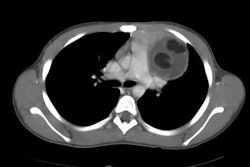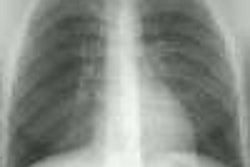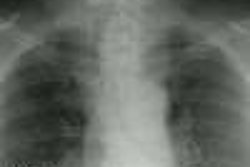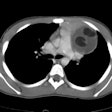Morgagni Hernia:
Clinical:
Morgagni hernias are uncommon protrusions of abdominal contents through an anterior defect in the diaphragm. They are the least common diaphragmatic hernia (2-3% of all diaphragmatic hernias). The foramina of Morgagni are small triangular areas bounded by diaphragmatic muscle fibers originating from the sternum and the seventh costal cartilages. The mammary vessels pass through these clefts. The hernia is most commonly unilateral and on the right (90% of cases) because the left side is protected by the pericardium and heart. The hernia sac usually contains omentum (abdominal fat), but may also contain bowel. The hernia occurs most commonly in obese, middle aged, females. The lesion is usually asymptomatic. Activities which increase intraabdominal pressure such as straining or weight lifting may influence enlargement of the hernia and are associated with an increased incidence of symptoms.X-ray:
On plain films the hernia appears as a smooth, well-defined opacity in the right cardiophrenic angle. Gas containing bowel and air-fluid levels may be present and are pathognomonic for the diagnosis, but are seen in a minority of cases. For lesions that do not contain bowel, CT will demonstrate a fat-containing cardiophrenic angle mass which contains associated omental or mesenteric vessels. The transverse colon will usually be situated immediately below the diaphragm in these cases. Reformatted images with helical CT may also aid in defining the diaphragmatic defect. Magnetic resonance imaging can also be used to evaluate patients with suspected Morgagni hernias.Images:
Case 1: Morgagni hernia in an infantREFERENCES:
(1) AJR 1997; Chest case of the day. Morgagni's hernia. 169 (July): 266-274 (No abstract available)
(2) Radiographics 2002; Gaerte SC, et al. Fat-containing lesions of the chest. 22: S61-S78




